容積ビデオシステム市場:現状分析と予測(2024年~2032年)
容積式キャプチャ(ハードウェア、ソフトウェア、およびサービス)の重視、コンテンツ配信別(プロジェクター、AR/VR HMD、スマートフォン、および容積式ディスプレイ)、アプリケーション別(スポーツ、イベント、& エンターテイメント、医療、教育&トレーニング、サイネージ&広告、およびその他); 地域/国
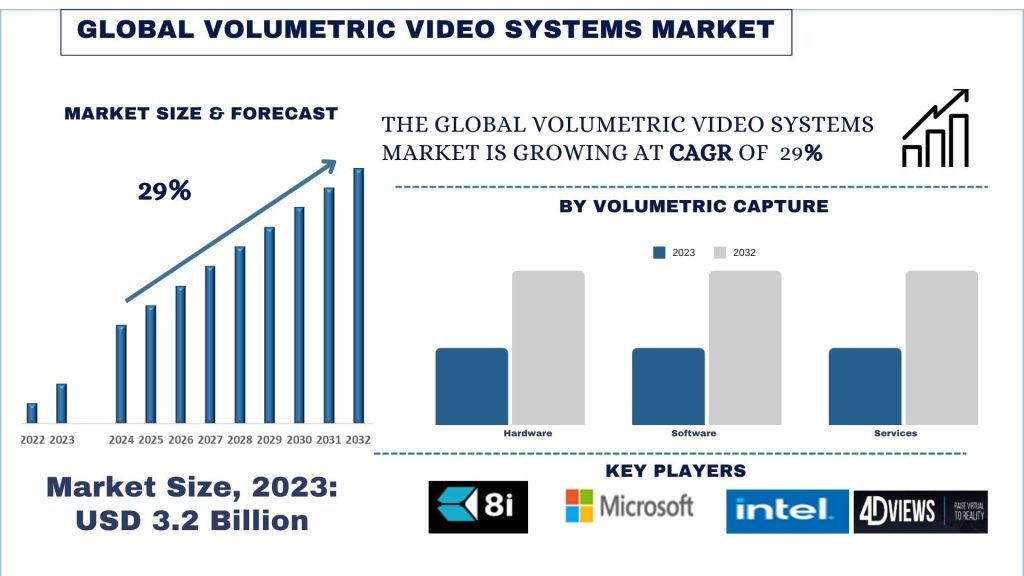
ボリュメトリックビデオシステム市場規模と予測
ボリュメトリックビデオシステム市場は、2023年に32億米ドルと評価され、予測期間(2024年~2032年)中に約29%の強いCAGRで成長すると予想されています。この成長は、拡張現実(AR)および仮想現実(VR)プラットフォームの普及が進んでいることに起因します。ボリュメトリックビデオシステムは、AR/VRプラットフォームとの統合が進んでおり、AR/VR体験のリアリズムと没入感を高めています。この統合により、魅力的なストーリーテリング、トレーニングシミュレーション、製品デモンストレーション、バーチャルツアーが可能になり、ボリュメトリックコンテンツの需要を促進しています。
ボリュメトリックビデオシステム市場分析
ボリュメトリックビデオシステムは、現実世界のオブジェクトや環境の3次元表現をキャプチャ、保存、表示するために使用される技術です。固定された視点からシーンをキャプチャする従来のビデオとは異なり、ボリュメトリックビデオシステムは複数の視点からの空間データを記録し、視聴者はさまざまな角度からコンテンツを操作できます。エンターテインメント、ゲーム、教育、マーケティングなど、複数の業界で没入型コンテンツ体験の需要が高まっています。ボリュメトリックビデオシステムは、従来のビデオ形式よりも没入型でインタラクティブな方法で視聴者を引き付けることができ、採用を促進しています。
ボリュメトリックビデオシステム市場セグメンテーションに関する洞察
ボリュメトリックビデオシステム市場は、ボリュメトリックキャプチャに基づいて、ソフトウェア、ハードウェア、およびサービスにセグメント化されています。2023年には、ハードウェアセグメントが市場の支配的なシェアを占めました。これは主に、高品質のボリュメトリックビデオコンテンツをキャプチャする高度なハードウェアコンポーネントの需要が増加しているためです。たとえば、Intelなどの企業は、ボリュメトリックビデオキャプチャ向けに調整された深度センシングカメラやその他の特殊なハードウェアソリューションを開発し、このセグメントの成長を促進しています。
コンテンツ配信別では、ボリュメトリックビデオシステム市場は、プロジェクター、AR/VR HMD、スマートフォン、ボリュメトリックディスプレイにセグメント化されています。AR/VR HMDセグメントは、2023年に市場の支配的なシェアを占めました。これは、さまざまな業界で拡張現実(AR)および仮想現実(VR)技術の採用が拡大していることに起因すると考えられます。Oculus(Meta Platforms(旧Facebook)が所有)やHTC Viveなどの企業は、AR/VR HMDの開発と商業化を主導しており、これらのデバイスと互換性のあるボリュメトリックビデオコンテンツの需要を促進しています。
アプリケーション別では、ボリュメトリックビデオシステム市場は、スポーツ、イベント、エンターテインメント、医療、教育とトレーニング、サイネージと広告、その他にセグメント化されています。サイネージと広告セグメントは、2023年に市場の支配的なシェアを占めました。これは、デジタルサイネージ、広告キャンペーン、ブランドプロモーションにおけるボリュメトリックビデオ技術の使用が増加していることを強調しています。たとえば、Light Field Labなどの企業は、小売スペースや公共の会場での没入型広告体験のために、大規模なボリュメトリックディスプレイを開発しています。
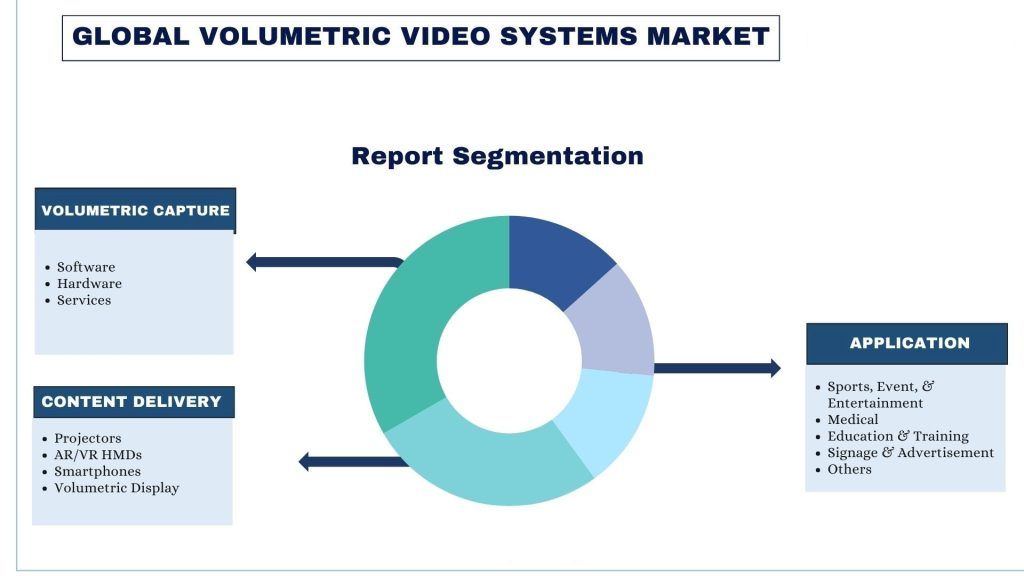
北米が2023年に市場の支配的なシェアを占めました
北米は、主要なプレーヤーの存在、技術の進歩、および高いレベルの消費者採用によって牽引され、2023年に市場のランドスケープを支配しました。Microsoft(Mixed Realityプラットフォームを使用)やMagic Leapなどの企業は、北米で先導し、この地域のイノベーションと市場の成長を推進しています。
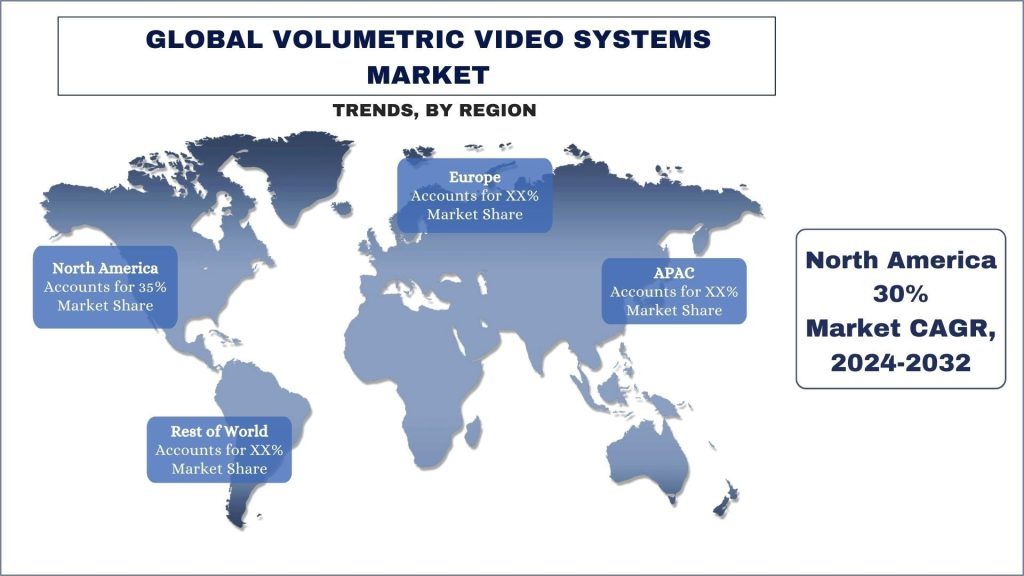
ボリュメトリックビデオシステム業界の概要
ボリュメトリックビデオシステム市場は競争が激しく、細分化されており、いくつかのグローバルおよび国際的な市場プレーヤーが存在します。主要なプレーヤーは、パートナーシップ、契約、コラボレーション、新製品の発売、地理的拡大、M&Aなど、市場での存在感を高めるためにさまざまな成長戦略を採用しています。市場で事業を展開している主要なプレーヤーは、4Dviews、8i、Alphabet Inc.、ソニー株式会社、Unity Technologies、Microsoft Corporation、Intel Corporation、The Coretec Group、Evercoast、およびMark Roberts Motion Control(MRMC)です。
ボリュメトリックビデオシステム市場ニュース
2023年1月、Unity TechnologiesとGoogle LLCは、それぞれのエコシステム内でライブゲームの成長と発展を加速するためのパートナーシップを発表しました。リアルタイム3D(RT3D)コンテンツの作成と強化のための有名なプラットフォームであるUnity TechnologiesとGoogle LLC間のコラボレーションは、開発者がマルチプレイヤーエクスペリエンスを作成するプロセスを簡素化することに重点を置いています。
2022年8月、Unity TechnologiesはMercedes-Benz Group AGと提携しました。Unity Technologiesエンジンは、メルセデス・ベンツのオペレーティングシステムのインフォテインメントセグメントを強化します。この統合は、2024年から始まる初期の車両モデルへの展開が予定されています。メルセデス・ベンツは、Unity Industrial Collectionを使用して、車載コックピットのユーザーインターフェイス(UI)を設計し、さまざまなアプリケーションを含みます。
ボリュメトリックビデオシステム市場レポートの対象範囲
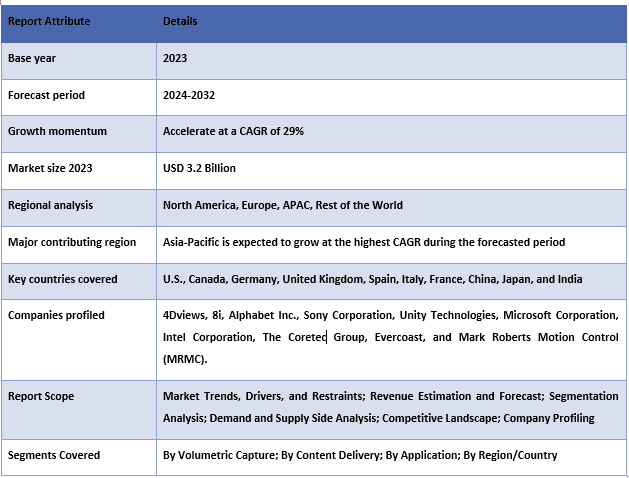
このレポートを購入する理由:
- この調査には、認証された主要な業界専門家によって検証された市場規模と予測分析が含まれています。
- このレポートは、業界全体のパフォーマンスの概要を一目で示します。
- このレポートでは、主要なビジネス財務、製品ポートフォリオ、拡張戦略、および最近の開発に重点を置いて、著名な業界の同業者の詳細な分析を取り上げています。
- 業界で普及している推進要因、制約、主要なトレンド、および機会の詳細な調査。
- この調査では、さまざまなセグメントにわたる市場を包括的にカバーしています。
- 業界の地域レベルの分析の詳細な調査。
カスタマイズオプション:
世界のボリュメトリックビデオシステム市場は、要件またはその他の市場セグメントに応じて、さらにカスタマイズできます。これに加えて、UMIは、お客様独自のビジネスニーズがあることを理解しているため、お客様の要件に完全に適合するレポートを入手するために、お気軽にお問い合わせください。
目次
Volumetric Video Systems市場分析(2024年~2032年)の調査方法
世界のVolumetric Video Systems市場の過去の市場を分析し、現在の市場を推定し、将来の市場を予測することは、世界の主要地域におけるVolumetric Video Systemsの採用を構築し分析するために行われた3つの主要なステップでした。過去の市場数値を収集し、現在の市場規模を推定するために、徹底的な二次調査が実施されました。次に、これらの洞察を検証するために、多数の調査結果と仮定が考慮されました。さらに、世界のVolumetric Video Systems市場のバリューチェーン全体にわたる業界の専門家との広範な主要インタビューも実施されました。主要なインタビューを通じて市場数値を仮定および検証した後、トップダウン/ボトムアップアプローチを採用して、市場全体の規模を予測しました。その後、市場の分解とデータ三角測量の手法を採用して、業界に属するセグメントおよびサブセグメントの市場規模を推定および分析しました。詳細な方法論を以下に説明します。
過去の市場規模の分析
ステップ1:二次情報源の詳細な調査:
年次報告書および財務諸表、業績プレゼンテーション、プレスリリースなどの企業内情報源、およびジャーナル、ニュースおよび記事、政府刊行物、競合他社の刊行物、セクターレポート、サードパーティデータベース、その他の信頼できる刊行物などの外部情報源を通じて、Volumetric Video Systems市場の過去の市場規模を取得するために、詳細な二次調査が実施されました。
ステップ2:市場セグメンテーション:
Volumetric Video Systems市場の過去の市場規模を取得した後、主要地域のさまざまなセグメントおよびサブセグメントに関する過去の市場の洞察とシェアを収集するために、詳細な二次分析を実施しました。主要なセグメントは、Volumetric Capture、コンテンツ配信、およびアプリケーションとしてレポートに含まれています。さらに、全体的な採用状況を評価するために、国レベルの分析を実施しました。
ステップ3:要因分析:
さまざまなセグメントとサブセグメントの過去の市場規模を取得した後、Volumetric Video Systems市場の現在の市場規模を推定するために、詳細な要因分析を実施しました。さらに、Volumetric Video Systems市場のVolumetric Capture、コンテンツ配信、およびアプリケーションなどの従属変数と独立変数を使用して、要因分析を実施しました。世界のVolumetric Video Systems市場セクターにおけるトップパートナーシップ、合併と買収、事業拡大、および製品の発売を考慮して、需要と供給側のシナリオについて徹底的な分析を実施しました。
現在の市場規模の推定と予測
現在の市場規模:上記の3つのステップからの実用的な洞察に基づいて、現在の市場規模、世界のVolumetric Video Systems市場の主要なプレーヤー、およびセグメントの市場シェアに到達しました。必要な割合のシェア分割と市場の分解はすべて、上記の二次的アプローチを使用して決定され、主要なインタビューを通じて検証されました。
推定と予測:市場の推定と予測では、推進要因とトレンド、制約、および利害関係者が利用できる機会を含むさまざまな要因に重みが割り当てられました。これらの要因を分析した後、関連する予測手法(つまり、トップダウン/ボトムアップアプローチ)を適用して、世界の主要市場全体のさまざまなセグメントおよびサブセグメントの2032年の市場予測に到達しました。市場規模を推定するために採用された調査方法には、以下が含まれます。
- 収益(米ドル)の観点から見た業界の市場規模と、国内の主要市場全体でのVolumetric Video Systems市場の採用率
- 市場セグメントおよびサブセグメントのすべての割合のシェア、分割、および分解
- 提供される製品の観点から見た、世界のVolumetric Video Systems市場の主要なプレーヤー。また、この急速に成長している市場で競争するために、これらのプレーヤーが採用した成長戦略
市場規模とシェアの検証
一次調査:主要地域全体のトップレベルのエグゼクティブ(CXO / VP、営業責任者、マーケティング責任者、オペレーション責任者、地域責任者、カントリーヘッドなど)を含む、Key Opinion Leaders(KOL)との詳細なインタビューを実施しました。次に、一次調査の結果を要約し、統計分析を実行して、述べられた仮説を証明しました。一次調査からの入力は二次調査の結果と統合され、情報が実用的な洞察に変わりました。
さまざまな地域における一次参加者の分割
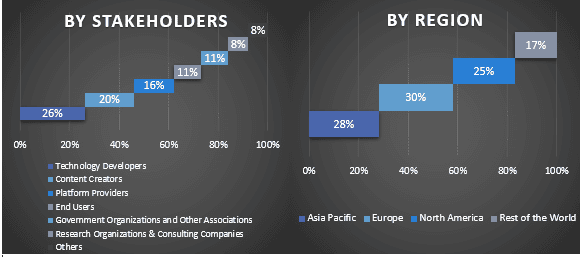
市場エンジニアリング
データ三角測量技術を採用して、市場全体の推定を完了し、世界のVolumetric Video Systems市場の各セグメントおよびサブセグメントの正確な統計数値に到達しました。世界のVolumetric Video Systems市場におけるVolumetric Capture、コンテンツ配信、およびアプリケーションの分野におけるさまざまなパラメーターとトレンドを調査した後、データをいくつかのセグメントとサブセグメントに分割しました。
グローバルVolumetric Video Systems市場調査の主な目的
グローバルVolumetric Video Systems市場の現在および将来の市場トレンドは、調査で正確に指摘されました。投資家は、調査で実施された定性的および定量的分析に基づいて、投資に関する裁量を判断するための戦略的な洞察を得ることができます。現在および将来の市場トレンドは、地域レベルでの市場全体の魅力を決定し、産業参加者が未開拓の市場を活用して、ファーストムーバーアドバンテージから利益を得るためのプラットフォームを提供します。調査のその他の定量的な目標には、次のものがあります。
- 金額(米ドル)の観点から、Volumetric Video Systems市場の現在および予測される市場規模を分析します。また、さまざまなセグメントおよびサブセグメントの現在および予測される市場規模を分析します。
- 調査のセグメントには、Volumetric Capture、コンテンツ配信、およびアプリケーションの分野が含まれます。
- Volumetric Video Systemsの規制フレームワークを定義および分析します
- さまざまな仲介業者の存在に伴うバリューチェーンを分析するとともに、業界の顧客および競合他社の行動を分析します。
- 主要地域におけるVolumetric Video Systems市場の現在および予測される市場規模を分析します。
- レポートで調査された地域の主要国には、アジア太平洋、ヨーロッパ、北米、およびその他の地域が含まれます
- Volumetric Video Systems市場の企業プロファイルと、急速に成長している市場で維持するために市場プレーヤーが採用した成長戦略
- 業界の詳細な地域レベルの分析
よくある質問 よくある質問
Q1: Volumetric Video Systems市場の現在の市場規模と成長の可能性は?
Q2:容積ビデオシステム市場の成長を牽引する要因は何ですか?
Q3: 立体映像キャプチャ別で、立体映像システム市場において最大のシェアを占めるセグメントはどれですか?
Q4: Volumetric Video Systems市場における新興技術とトレンドは何ですか?
Q5:どの地域がVolumetric Video Systems市場を支配するでしょうか?
関連 レポート
この商品を購入したお客様はこれも購入しました










